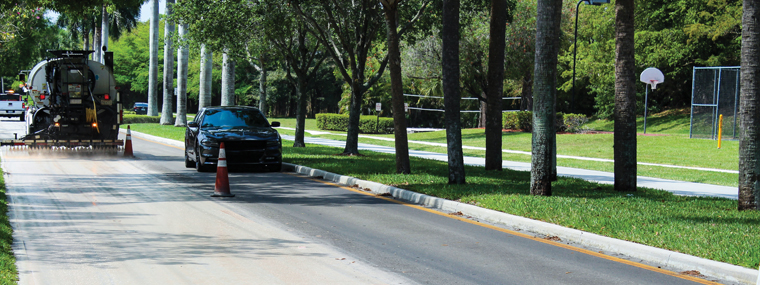
Preparing HOAs for Pavement Preservation
By Chris Evers / Published January 2018

So, the HOA just resurfaced the roads and everyone crossed “pavements” off of the proverbial to-do list. Does that mean we just sit around and wait another 15 years before thinking about preserving them? Not if the goal is to spend less money and have higher quality roads. Truthfully, most private communities live on “Someday Isle.” They finish resurfacing the roads, breathe a sigh of relief, and then say, “Someday we’ll start preserving these roads, so they don’t start deteriorating like they did last time.”

HOAs commonly wait too long to start a preventive road maintenance program even though we routinely perform preventive maintenance (PM) on other physical assets around our communities. The adage “You don’t have to be great to get started, but you have to get started to be great” definitely applies to roads! So, let’s get started.
Education is Step One
“If you do what is easy, your life will be hard; if you do what is hard, your life will be easy.” Famous motivational speaker Les Brown got it right. But it’s not easy to be a proponent for preserving what others think is a perfectly good road. Here’s what we know to be true: in the long run, preventive maintenance is the best approach, not only for the health of the road, but also for the health of our budgets, because when you take into consideration the long-term costs over the total life of our roads, preservation is the most cost-effective strategy.
Step one, then, in persuading your HOA to preserve its roads is to use compelling life-cycle cost analysis data, much of which can be readily found on the internet or by simply reviewing the approach your local public agencies and the Federal Highway Administration take with our public roadways. In early November 2017, 50 people representing dozens of cities and counties crammed into a room at the FDOT office in Orlando to listen to the FHWA and industry experts explain why everyone should consider adopting a pavement preservation program.

Many public works agencies around Florida employ PM strategies to extend road life, having learned through experience that “worst first” is the worst strategy you can have, especially given the public sector’s mandate to be fiscally responsible for the tax dollars they spend. By doing some long-range planning, HOAs can extend the life of their roads. Do your research, include preservation in your road reserve study, present the options early on, and consider engaging experts who can help.
Step Two is Planning
The best time to act is when an HOA is either looking to resurface its roads or has recently completed resurfacing them. You must identify the current condition of your roadways to determine the correct preservation strategy to use. You wouldn’t use maltene-based rejuvenation on a road that’s seven years old, but you might use a high-density mineral bond or micro-surfacing. If the road is already exhibiting some minor distresses, then “top-of-the-curve” strategies such as rejuvenation should no longer be considered. Putting the right treatment on the right road at the right time are the three boxes that should always be checked when exploring preservation.

Money is another important consideration. Using some simple calculations, the HOA can uncover what the return on investment (ROI) will be and what effect the proposed program will have on its road reserves.
Step 1—Original Cost and Replacement Cost: Start with the original rehabilitation cost for the HOA roads (in this example, we’ll use the round figure of $500,000). To calculate replacement cost at the end of the road’s design life, first adjust for inflation by multiplying the original rehabilitation cost by a likely inflation rate (we’ll use 2 percent per year for 20 years). That gives you a projected replacement cost of $742,974. Now, simply divide by the road’s design life (using 20 years for our projected life cycle) to get a required annual reserve funding of $37,149.
Step 2—Preservation Cost: Next, you need to determine how many years of life extension the preservation work is intended to provide and adjust the expected cost of necessary future preservation work by the cost of inflation. Frequency of treatments and related costs will be determined by your choice of product used. For a maltene-based rejuvenator, rejuvenation treatments are required in years two and seven and will extend road service life an additional eight to ten years.
Step 3—New Design Life: Now you add the years of anticipated life extension (let’s use an average of nine years) to the original design life of 20 years, to get a total design life with preservation of 29 years.
Step 4—New Replacement Cost: This calculation is tricky, because it requires amortizing costs across the total service life of the roadways. A qualified pavement preservation specialist can help you work through these numbers using your own costs and figures. Essentially though, a properly preserved road at the end of its 29 year life-cycle will be in better condition than an unpreserved roadway at the end of its 20 year design life. So not only do you benefit from an added nine years of service life, which directly reduces your annual reserve funding, but you also benefit from reduced reconstruction requirements at the end of the road’s life cycle.

In our experience, typical cost reductions when roads are preserved using a maltene-based rejuvenator average 25 percent. When you consider the available capital resulting from these savings, the actual return on investment can be as high as 300 percent.
Step Three is The Decision
With the preservation strategy (Right Treatment) selected and the date of application (Right Time) chosen, the decision making is upon you. Using everyday analogies such as changing the oil or brushing your teeth can be effective in explaining why the HOA would be smart to employ pavement preservation to extend the life of the community’s roads. Performing the life-cycle projections to show how the ROI will in fact reduce the HOA’s required reserve funding will also go a long way toward convincing board members that pavement preservation makes good sense. A good preventive maintenance partner can provide you with photos or videos of real-world preservation projects, and may even be able to give you a field trip to a nearby community to see first-hand the results of preventive road maintenance, helping reduce uncertainty levels. Remember: good communication with your residents both during the decision-making process and actual construction will help ensure success.
Now, all that remains is the actual bidding and subsequent construction, which, with an experienced partner, should be the easy part! Best of luck and get started!
FAQs
How do I know which treatment to use? Doing research on the internet is a great first step. Independent resources, such as the National Center for Pavement Preservation (pavementpreservation.org), are a good place to start.
What about getting the right contractor? That’s an article all to itself! In general, start with a list of qualifications, check the contractors’ references, ask about past experience with the particular process/products they will be using, and find out whether on-site supervision is part of their process.
Are there environmental concerns with these products? There can be. Always use asphaltic materials with asphalt roads. Coal tar is both carcinogenic and dissimilar to asphalt, and therefore not the best choice for preserving asphalt roads sustainably.
Conclusion
The most important take-away is that pavements, much like everything else in life, last longer when they are properly maintained. When exposed to the punishing effects of sun, rain, and traffic, asphalt roads eventually succumb to nature, and far too often this occurs earlier than their anticipated design life, leaving the HOA with fewer options and higher bills. Pavement preservation applied at the right time can yield a 200 to 300 percent return on investment. Who wouldn’t love to see that kind of return?
Chris Evers
Technical Representative for Pavement Technology Inc.
Chris Evers has served as a technical representative for Pavement Technology Inc. since 2011 and has been involved in the road building business since 1996. He is a past president of the APWA Florida Chapter and an active participant on its Legislative Affairs committee. He founded and continues to moderate the annual APWA International Public Works Director Roundtable and was also instrumental in founding the Florida Pavement Preservation Council. Chris is a popular pavement preservation educator/speaker throughout Florida and resides in Vero Beach. For more information on Pavement Technology, visit www.pavetechinc.com or contact Chris via info@pavetechinc.com.


